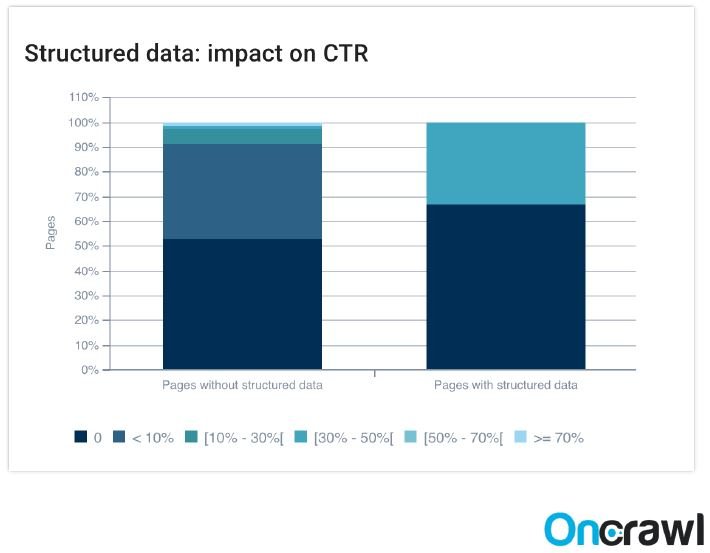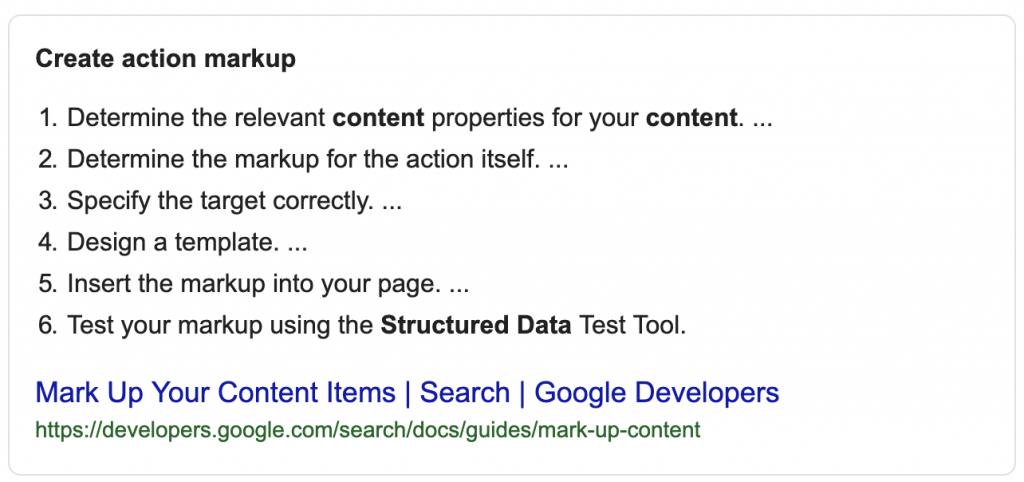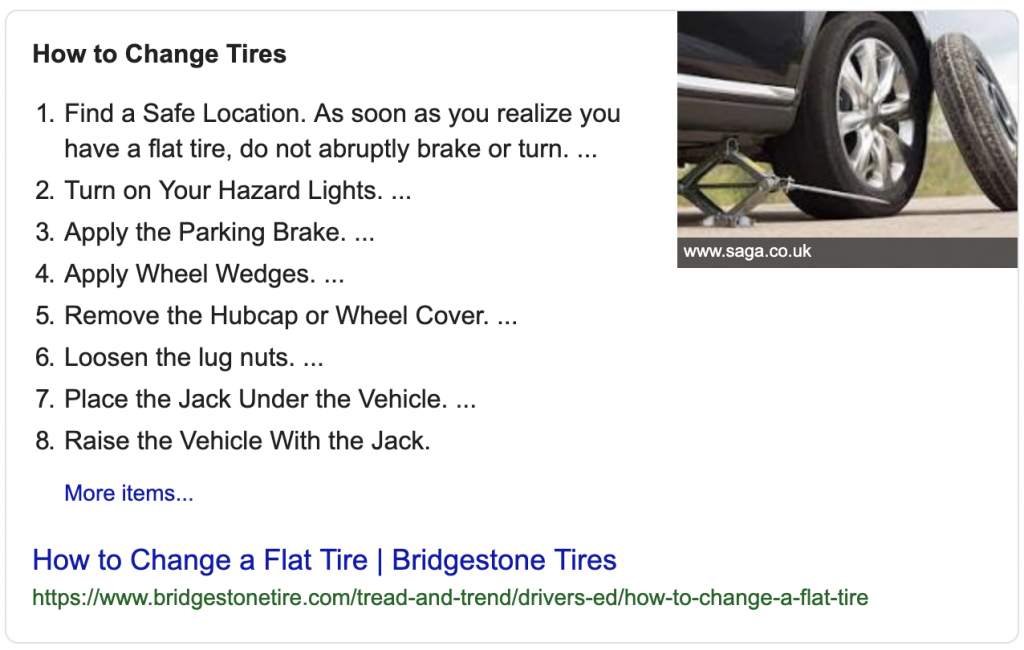Google has been pushing SEOs to use structured data on all their content for some time, but structured data comes with a nasty little secret which I saw revealed in a single slide yesterday. Sometimes, structured data will KILL your content.
Here’s why…

When Oncrawl‘s Lionel Lionel Kappelhoff-Lançon put this slide up at Advanced Search Summit (which was Brilliant, by the way), he was showing how adding structured data to a page significantly increased the impact on CTR (Click Through Rate). That’s great right? I looked hard at the picture as Lionel was talking and I saw the second story. The slide above, in fact, aggregates all the pages on a site and indeed shows that before the structured data was implemented, hardly any pages had a “high” clickthrough rate. Suddenly there are CTRs in the 70% range… But it also shows an increase in the number of pages with NO CTR!
Clean Data = Dirty Motive
The dirty secret is that structured data, in fact, polarises your content, making it a binary decision in the search results. your content either becomes EXTREMELY attractive… or… on the dark side… becomes so useful and structured, that Google can simply assimilate the structured data as its own and put it into its knowledge graph… thereby answering the question for the user with no incentive for the user to click through to the site.
How Structured Data affects your content
- Google can derive clear meaning from structured data.
- Google can then store this in a database that can be accessed much faster and with a higher level of confidence in the quality of response.
- The database and its content
is then entirely owned and controlled by Google. You may lose any intellectual claim to the original content.
That’s a bit crap for most business models.
It poses a dilemma. I think it would be bad advice if I were to suggest you don’t use structured data. In my experience, advice that goes against Google’s advice rarely works out well (except maybe building links!).
So what to do? The solution is baked into your business proposition and how it is manifested in your content. If you create content that can then be assimilated into the knowledge graph, you need to ensure that the user still needs to engage with you, to be able to complete their transaction.
Tips to make your structured data more effective (for your site)
If you list the best hotels in Napa, this makes more sense if YOUR hotel is
You can also make sure you add a call to action within the structured data itself. Here Google is eating its own dogfood, by providing a tool within the markup, which you’ll need to complete this list:

Another very useful trick is to add too many structured data items for Google to display in full. Look at this result:

Another great example of this:

Conclusion
I think the moral of the tale, here. is one that has not escaped many of my colleagues in this space. Be a little wary of your big friendly giant, Google. Their first allegiance is to their searchers. The second is to their shareholders. The third is to their Adwords and paying customers. Website owners do not appear on their list of allegiances at all. As long as you think you need them more than they need you, the balance works for them.
Does the balance work for you?
On 23rd May I’ll be interviewing Julie Joyce about Internal Links as part of OnCrawl’s Inorbit series.
14 Comments
Gilbert Bentley · 4th May 2019 at 12:46 am
This is absolutely brilliant. I’m currently doing an overhaul on massive directory website and I’ll be using these points as I fine tune the structured data. Thank you!
dixonhjones · 4th May 2019 at 8:56 am
Thank you!
Omi Sido · 4th May 2019 at 11:56 am
Mate, love it! You have a good eye for detail
dixonhjones · 6th May 2019 at 10:37 am
Thanks, although I think I was just not stressed for a change as I wasn’t speaking. That meant I could actually look at the slides and other presentations with more clarity than normal.
Steven van Vessum · 6th May 2019 at 9:11 am
Thanks for sharing your thoughts Dixon!
I wasn’t at the conference, was anything said about the result in visits and revenue for this case study?
As in: did they gain more than they lost?
The amount of pages with low CTR went up significantly, but did the growth in CTR for other pages make up for that? (And did they get more visits and more revenue across the board?)
Curious to know, as that’s what it’s all about in the end (provided it’s sustainable).
dixonhjones · 6th May 2019 at 10:36 am
The presenter wasn’t focusing on the polarizing effect in his presentation, but to your point, he did say that for this site, adding in the structured data was a net win and worth doing.
Consulenza · 7th May 2019 at 7:09 am
This article from Dixon raises an interesting question that in my opinion Steven nailed: “did the growth in CTR for other pages make up for that?”. I my websites balance is working for me.
dixonhjones · 7th May 2019 at 10:07 am
Yep – that’s the immediate nub of the problem right now. However, once the transfer of knowledge is accepted… ie after a few tears have passed… then disputing a search engine’s right to use the information in this way will pass. Did you know, for example, that British Telecom (now BT) owned a patent for the Hyperlink!? In 2002 it lost a court case trying to protect its patent because they left it too long to try to defend. Imagine how different the web would be if they had won?
Dirk P Johnson · 6th May 2019 at 12:25 pm
Does using structured data also imply that you give search engines the right to us it as they see fit?
If so, then Google has won. If not, then “fair use” needs to be explored by the major publishers, to put a stop to this.
dixonhjones · 7th May 2019 at 10:02 am
That’s a question beyond my pay grade! I think it is complex and probably varies based on the country that the web site is hosted in or pertains to. To my simple mind, adding structured data to a site gives a search engine NO MORE rights to the content than a page without structured content. If you search for “Search engine Copyright law” you will find multiple, contradictory legal arguments and decisions over the years.
Samuel Lavoie · 7th May 2019 at 7:01 pm
Brilliant. Spot on the double-edged sword usage of Structured Data. Especially for Featured Snippets. At the end of the day it seems like a net win in most instance, and if not, might want to rethink your website’s reason to exist!
Shawn Cohen · 7th May 2019 at 11:23 pm
Maybe the talk addressed this question, but I’ve seen some indication that structured markup with errors can limit visibility. It might be assumed that the tags are error free but if not, merely having the markup wouldn’t be the issue so much as that it was implemented incorrectly.
dixonhjones · 8th May 2019 at 1:49 pm
Please elaborate with an example of what you mean.
Shawn Cohen · 20th May 2019 at 1:08 am
Sure, for example, after the medic update, webmd owned properties with flawless structured markup seem to have increased visibility whereas competitors who have organization, article, blogposting, etc tags implemented incorrectly have decreased rankings (like they have missing required elements). So the data referenced in the session in your post had decreased ctr and possibly decreased rankings but was that bc they merely had structured markup or bc it was implemented incorrectly?
I hope that makes more sense.
Shawn